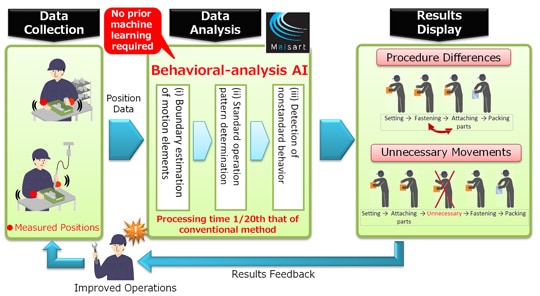 Mitsubishi Electric Corporation announced six new technologies, outlined below, at its annual Research and Development Open House held today at its headquarters in Tokyo, Japan, including three artificial intelligence (AI) technologies using the company’s proprietary Maisart®* AI.
Mitsubishi Electric Corporation announced six new technologies, outlined below, at its annual Research and Development Open House held today at its headquarters in Tokyo, Japan, including three artificial intelligence (AI) technologies using the company’s proprietary Maisart®* AI.
* Mitsubishi Electric’s AI creates the State-of-the-ART in technology
Mitsubishi Electric will have balanced short-, mid- and long-term research and development.
Mitsubishi Electric’s announced today that it has developed an artificial intelligence (AI) technology capable of fast stepwise learning using a simulator to efficiently complete motion learning in a relatively short time using the company’s Maisart AI technology.
The company has developed a unique behavioral-analysis artificial intelligence (AI) using the company’s Maisart AI technology. he new technology analyzes human movements immediately after collecting required measurement data, focusing on similarities in repeated movements. The technology is easy to apply at work sites because, unlike conventional behavior-analysis AI, it doesn’t require machine learning involving huge amounts of teaching data that must be introduced manually. Behavioral analysis can be performed at high speed, within just a few seconds or minutes, which is less than 1/20th of the time required for the company’s conventional method. Analysis can be performed quickly at work sites to provide rapid feedback on improving workers’ efficiency.
Mistubishi has developed what is believed to be the world’s smallest power unit for a two-motor hybrid electric vehicle (two inverters and one converter), measuring just 2.7 liters in volume, offering a world-leading 150 kVA/L power density.
It has developed sensing technology for highly accurate detection of vehicle perimeters even in dense fog or heavy rain.
Research and development efforts continue to focus on raising the detection accuracy of sensors used in autonomous-driving and driving-assistant systems. These systems rely on various kinds of sensors to confirm the positions, velocities, sizes, etc. of obstacles in the paths of vehicles. Until, however, conventional systems using such sensors have not performed well in dense fog or heavy rain conditions that lower electrical and laser wave permeability and camera visibility.
The new technology selects and integrates information from multiple sensors based on the reliability of the information. Time series data (velocity, width, orientation, distance, etc.) obtained from various sensors are analyzed in real-time to predict the reliability of each sensor’s information affected by weather, based on its respective features. By selecting and integrating information determined to be highly reliable, high-accuracy detection is possible even in rough weather. The technology was deployed with an autonomous emergency braking (AEB) system in tests to verify the performance of real vehicles in rough weather, and the AEB system was confirmed to achieve safe emergency braking even in conditions where sensors normally do not perform well. Going forward, the company will perform evaluation testing in actual environments and continue development of the technology with the aim of commercialization from the year 2023 onwards. The company expects future application of this technology in autonomous vehicles for safe and accurate lane changes even in rough weather.
And it has developed a simulation technology for predicting energy consumption and comfort levels to operate net zero energy buildings (ZEBs).
Mistubishi has developed what the company believes to be the world’s first technology capable of simultaneous highly accurate multilingual speech recognition without being informed which language is being spoken, even when multiple people are speaking, using the company’s compact Maisart AI.
The novel technology, Seamless Speech Recognition, incorporates Mitsubishi Electric’s proprietary Maisart®* compact AI technology and is built on a single system that can simultaneously identify and understand spoken languages. In tests separately involving 5 and 10 languages, all conducted in low-noise environments, the system achieved recognition with over 90 percent and 80 percent accuracy, respectively, without being informed which language was being spoken. The technology also can understand multiple people speaking either the same or different languages simultaneously.
The new system uses Mitsubishi Electric’s proprietary Hybrid CTC/Attention Method for end-to-end speech recognition, which significantly improves the accuracy of the speech recognition process. The method is built on two representative methods for end-to-end speech recognition-connectionist temporal classification (CTC) and attention-based decoding-combining their advantages while alleviating their drawbacks. In particular, the hybrid method benefits from CTC’s capability to predict accurate alignments between input speech signals and output characters, and the attention method’s capability to consider interdependences across time of the acoustic and language characteristics of speech.